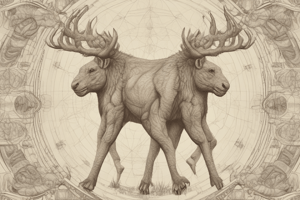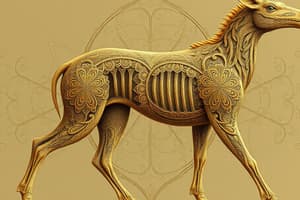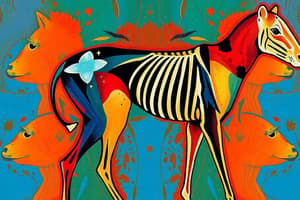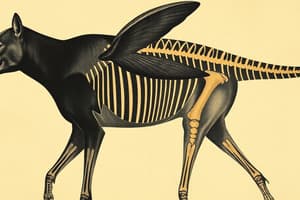Podcast
Questions and Answers
What type of symmetry do mammals, such as humans, possess?
What type of symmetry do mammals, such as humans, possess?
- Pseudocoelom
- Asymmetry
- Radial symmetry
- Bilateral symmetry (correct)
Which term describes the mouth developing first during embryonic stages?
Which term describes the mouth developing first during embryonic stages?
- Invertebrates
- Protostomes (correct)
- Deuterostomes
- Eumetazoans
How are vertebrates classified within the animal kingdom?
How are vertebrates classified within the animal kingdom?
- By their body symmetry
- By their reproductive methods
- By their habitat type
- By having a backbone (correct)
What type of body cavity is characterized as a true body cavity, fully lined with tissue?
What type of body cavity is characterized as a true body cavity, fully lined with tissue?
What is the term that refers to animals without a backbone?
What is the term that refers to animals without a backbone?
What is the function of nitric oxide in the process of erection?
What is the function of nitric oxide in the process of erection?
Where does fertilization typically occur in the female reproductive system?
Where does fertilization typically occur in the female reproductive system?
What condition is defined as the hardening and narrowing of arteries due to plaque buildup?
What condition is defined as the hardening and narrowing of arteries due to plaque buildup?
What is chyle in the lymphatic system?
What is chyle in the lymphatic system?
What happens to the heart muscle if blood flow is completely blocked?
What happens to the heart muscle if blood flow is completely blocked?
Which phylum is characterized by animals with specialized stinging cells?
Which phylum is characterized by animals with specialized stinging cells?
What is a defining feature of mollusks?
What is a defining feature of mollusks?
Which class of echinoderms includes sea stars?
Which class of echinoderms includes sea stars?
What is the primary feature of Phylum Arthropoda?
What is the primary feature of Phylum Arthropoda?
Which type of invertebrates are considered pests but also play important roles in ecosystems?
Which type of invertebrates are considered pests but also play important roles in ecosystems?
What type of reproduction can sponges perform?
What type of reproduction can sponges perform?
Which of the following phyla has organisms that often serve as parasites?
Which of the following phyla has organisms that often serve as parasites?
What structure do echinoderms use to assist in movement and feeding?
What structure do echinoderms use to assist in movement and feeding?
What type of symmetry do echinoderm larvae exhibit?
What type of symmetry do echinoderm larvae exhibit?
What is the primary component of the arthropod exoskeleton?
What is the primary component of the arthropod exoskeleton?
Which part of the body do arthropods primarily develop from?
Which part of the body do arthropods primarily develop from?
Where is the biological clock located in mammals?
Where is the biological clock located in mammals?
Which of the following best describes the term 'gametogenesis'?
Which of the following best describes the term 'gametogenesis'?
What is the first stage of development following fertilization of the zygote?
What is the first stage of development following fertilization of the zygote?
Which organ is responsible for sperm production in males?
Which organ is responsible for sperm production in males?
What role does the cremasteric reflex play in the male reproductive system?
What role does the cremasteric reflex play in the male reproductive system?
What is a characteristic of effective animal communication?
What is a characteristic of effective animal communication?
Flashcards are hidden until you start studying
Study Notes
Animal Body Plans
- Animal body plans define the structural organization and features that categorize organisms within evolutionary and developmental biology.
- Body symmetry is a key differentiator: radial symmetry allows division leading to identical halves, while bilateral symmetry means mirrors along a central line.
- Mammals, including humans, exhibit bilateral symmetry; asymmetry represents a rare case without defined symmetry.
- Structural organization includes cavities (coelom, pseudocoelom) and tissue layers, which are classified as eumetazoans for those with true tissues.
- Protostomes develop mouths first, while deuterostomes form anuses first during embryonic development.
Classification of Animals
- Kingdom Animalia comprises multicellular heterotrophs lacking cell walls, categorized into vertebrates and invertebrates.
- Vertebrates possess a spinal column; major vertebrate groups include fish, amphibians, reptiles, birds, and mammals (all under Phylum Chordata).
- Over 90% of animal species are invertebrates, appearing in more than 30 phyla and over 1.3 million species.
Key Invertebrate Phyla
- Phylum Porifera: Sponges are sessile filter feeders with porous bodies.
- Phylum Cnidaria: Jellyfish, corals, and sea anemones have specialized stinging cells.
- Phylum Mollusca: Soft-bodied animals with shells, classified into Gastropoda (snails), Bivalvia (clams), and Cephalopoda (squids).
- Phylum Arthropoda: Characterized by segmented bodies and exoskeletons, including insects, arachnids, and crustaceans.
- Phylum Echinodermata: Include sea stars and urchins, known for spiny skin and regeneration capabilities.
Reproductive Systems
- Male Reproductive System: Composed of external organs (penis and scrotum) and internal organs (testes, epididymis, etc.), vital for hormone regulation and sperm production.
- Female Reproductive System: Includes ovaries (gamete production), fallopian tubes (fertilization site), uterus (development of embryo), and vagina (birth canal).
Cardiovascular System
- The heart is a muscular organ pumping oxygenated and deoxygenated blood and comprises four chambers: right atrium, right ventricle, left atrium, left ventricle.
- Four valves regulate blood flow, preventing backflow and ensuring directional movement through the heart.
- Coronary heart disease occurs from plaque buildup in coronary arteries, potentially leading to angina and heart attacks.
Lymphatic System
- Functions as an accessory to the circulatory system, overseeing fluid drainage and immune responses.
- Lymphatic vessels transport lymph, which has white blood cells but no red blood cells or platelets.
- Lymph nodes filter out infections, and lymphatic capillaries collect interstitial fluid, which can lead to edema if fluid is not returned to the bloodstream.
General Blood Composition
- Red blood cells lack nuclei and typically comprise 40-45% of blood volume, responsible for oxygen transport in conjunction with plasma, white blood cells, and platelets.### Function and Structure of Red Blood Cells
- Primary role is to carry oxygen from lungs to body tissues and transport carbon dioxide back to the lungs.
- Contain hemoglobin, a protein that binds oxygen due to its iron atom.
- Produced in red bone marrow by stem cells called hemocytoblasts, which differentiate into protoerythroblasts.
- Protoerythroblasts lose their nuclei, developing into mature red blood cells.
- Mature red blood cells circulate for approximately 120 days before being removed by liver and spleen.
Disorders Related to Red Blood Cells
- Anemia is characterized by a lower-than-normal count of red blood cells.
ABO Blood Group System
- Blood types are determined by the presence or absence of A and B antigens on red blood cells.
- Four blood types: A, B, AB, and O.
- Type A has A antigens and produces anti-B antibodies.
- Type B has B antigens and produces anti-A antibodies.
- Type AB has both A and B antigens and produces no antibodies, making it the universal recipient.
- Type O has no antigens and produces both anti-A and anti-B antibodies, making it the universal donor.
Importance of Blood Type in Transfusions
- Incorrect blood transfusion leads to agglutination, where red blood cells clump, disrupting circulation.
Blood Circulation Pathway
- Blood exits the heart through arteries, which are large vessels with elastic walls and smooth muscle.
- Arteries branch into arterioles, smaller vessels with less elasticity and controlled blood flow.
- Blood enters capillaries, the smallest vessels with thin walls facilitating gas and nutrient exchange.
- Blood leaves capillaries as deoxygenated, having released oxygen and absorbed carbon dioxide.
- Deoxygenated blood moves into venules, leading to larger veins that return blood to the heart.
Vein Structure and Function
- Veins have thinner walls due to lower pressure than arteries.
- Contain one-way valves to prevent backflow and keep blood flowing towards the heart.
- Skeletal muscle contractions assist in pushing blood back to the heart.
Studying That Suits You
Use AI to generate personalized quizzes and flashcards to suit your learning preferences.




